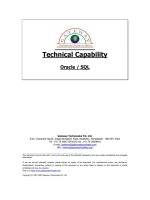Tài liệu General Considerations docx
Bạn đang xem bản rút gọn của tài liệu. Xem và tải ngay bản đầy đủ của tài liệu tại đây (13.12 KB, 1 trang )
[ Team LiB ]
A.1 General Considerations
The most evident difference between C# and Visual Basic (VB) syntax is that C# uses the
semicolon (;) as a statement terminator, whereas VB uses a line break. As a result, a
statement in C# can occupy multiple lines as long as it is terminated with a semicolon. A
VB statement must occupy only a single line. Multiline statements in VB must appear
with the VB line continuation character (a space followed by an underscore) on all but
the last line.
A second, and not quite so evident, difference is that C# is case sensitive, whereas VB
isn't. (Uniform case use for VB code is enforced by the Visual Studio environment, but it
is by no means required.)
Finally, all types and their members have access modifiers that determine the type or
member's accessibility. The keywords for these access modifiers are nearly identical in
VB and C#, as Table A-1
shows.
Table A-1. Access modifiers in C# and VB
C# keyword VB keyword
public Public
private Private
protected Protected
internal Friend
protected internal Protected Friend
[ Team LiB ]









